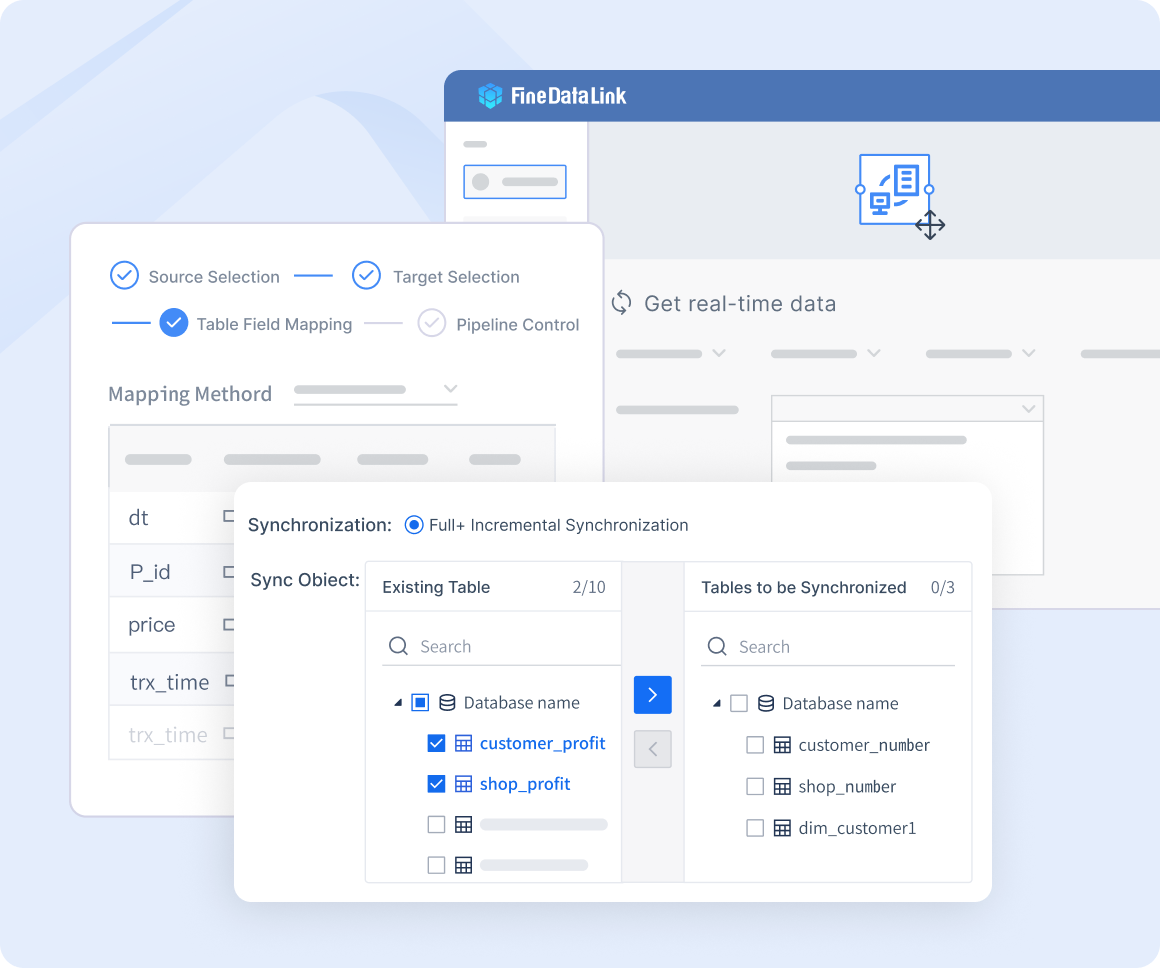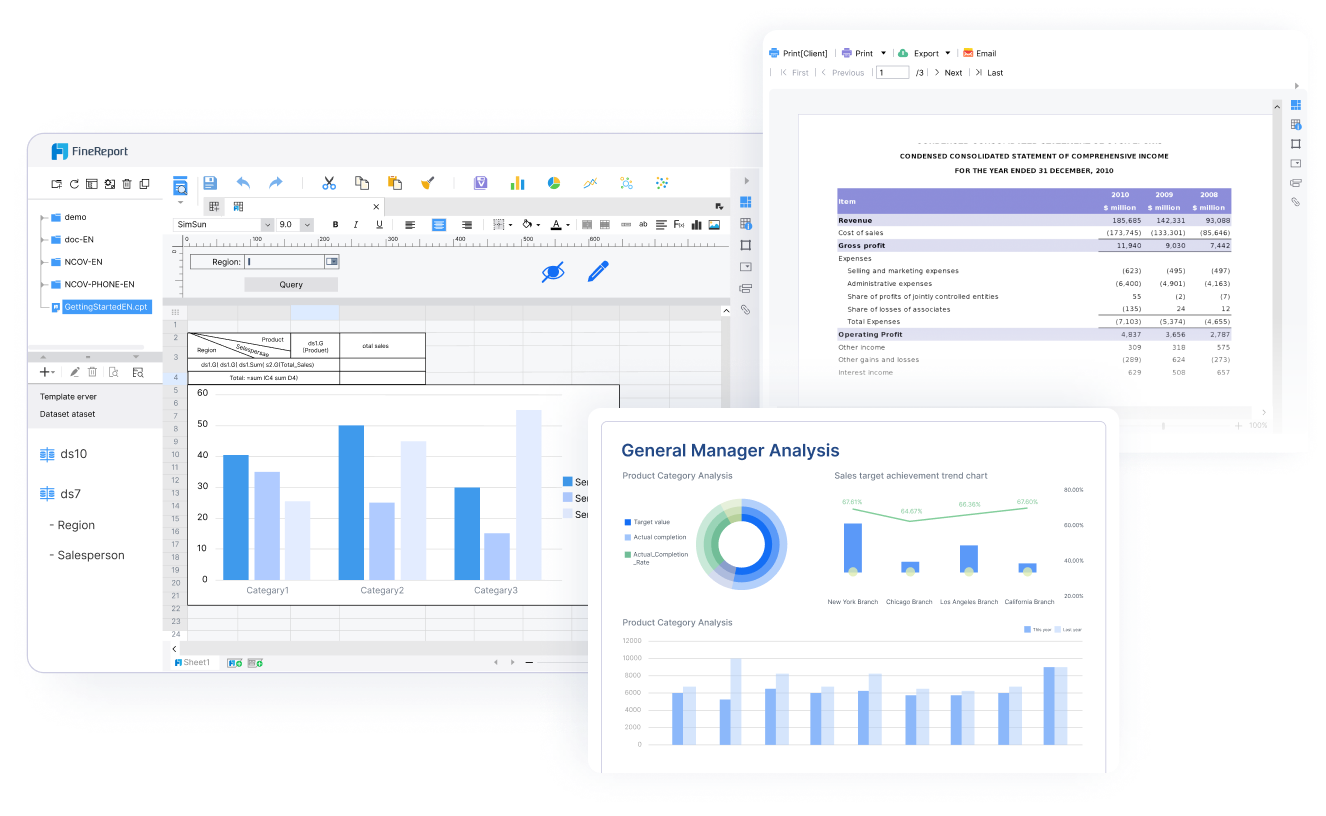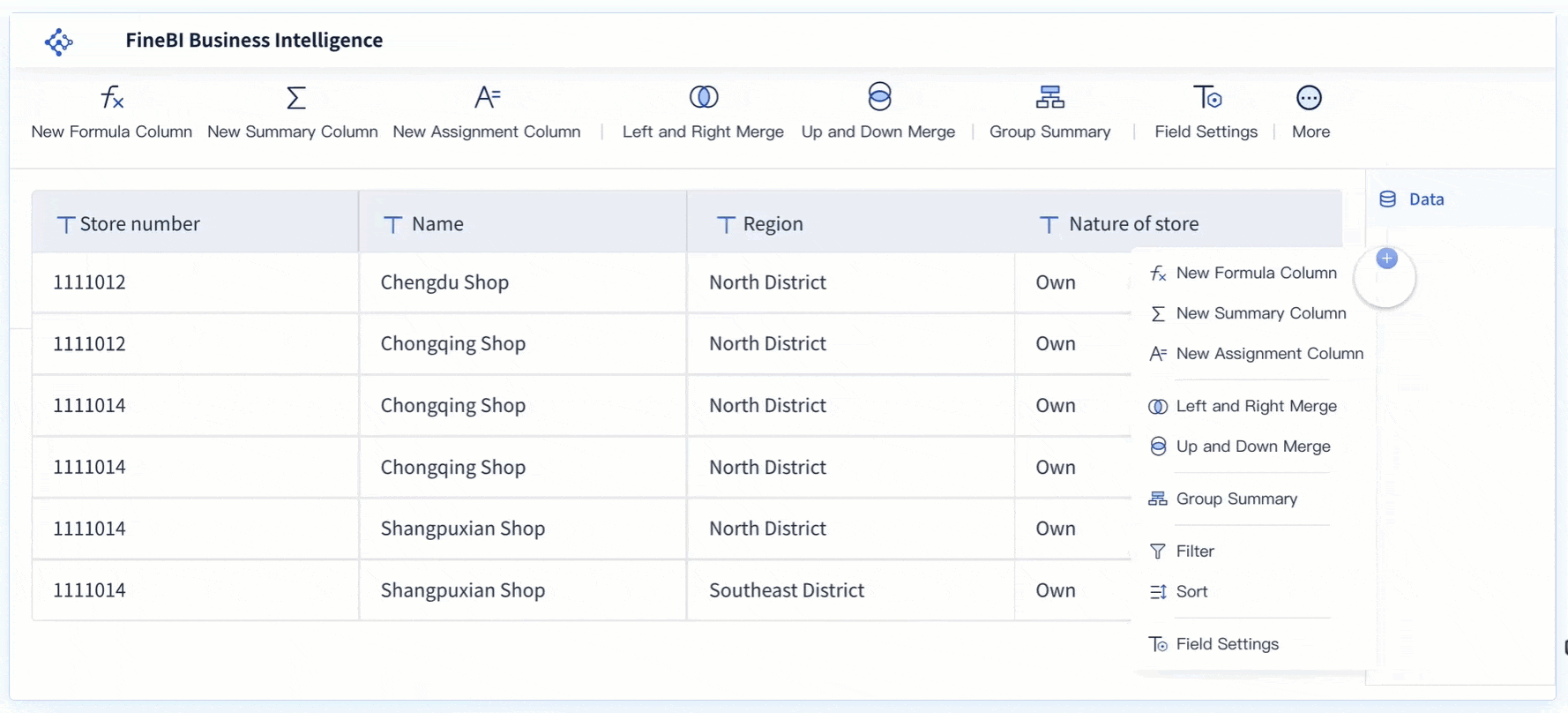

Data reliability refers to the consistency and dependability of data over time. It ensures that data remains accurate and complete, which is crucial for making informed decisions. In today's data-driven world, reliable data serves as the backbone of strategic planning and operational efficiency. Without it, businesses risk basing their strategies on faulty assumptions, leading to misguided actions and potential financial losses. Tools like FineDataLink, FineReport, and FineBI play a pivotal role in maintaining data reliability by providing robust data integration, reporting, and analytics solutions.
Understanding Data Reliability
Definition and Explanation of Data Reliability
Data reliability refers to the consistency and dependability of data over time. Reliable data remains accurate, complete, and trustworthy, serving as a solid foundation for decision-making. It ensures that data maintains its integrity across various systems and transformations. This reliability is crucial for effective data management, analytics, and business intelligence.
Key Characteristics of Reliable Data
Reliable data exhibits several key characteristics:
- Accuracy: Data must accurately represent the real-world conditions it describes.
- Consistency: Data should remain consistent across different datasets and systems.
- Completeness: All necessary data should be present without any missing elements.
- Timeliness: Data should be up-to-date and available when needed.
These characteristics ensure that data can be trusted for making informed decisions.
Common Misconceptions about Data Reliability
Many people hold misconceptions about data reliability. Some believe that data reliability only concerns data accuracy. However, reliability encompasses more than just accuracy; it includes consistency, completeness, and timeliness. Others think that data reliability is solely the responsibility of IT departments. In reality, ensuring data reliability requires collaboration across various departments, including data governance and management teams.
Examples of Unreliable Data
Unreliable data can lead to significant issues in decision-making processes. It often results from data breaches, unauthorized access, or data theft, which compromise data integrity.
Case Studies of Data Failures
Case Study: A Retail Giant's Data Breach
A major retail company experienced a data breach that exposed sensitive customer information. The breach resulted from inadequate security measures, leading to unauthorized access. This incident highlighted the importance of data security in maintaining data reliability.
Case Study: Financial Institution's Inaccurate Reporting
A financial institution faced challenges due to inaccurate data reporting. The errors stemmed from inconsistent data entry practices and outdated systems. This case underscores the need for accurate and consistent data to ensure reliability.
Impact of Unreliable Data on Decision-Making
Unreliable data can severely impact decision-making. When data lacks reliability, organizations risk making decisions based on faulty assumptions. This can lead to misguided actions, financial losses, and reputational damage. For instance, data breaches and unauthorized access can compromise data reliability, affecting strategic planning and operational efficiency.
Measuring Data Reliability
Metrics and Indicators of Data Reliability
Data reliability hinges on several key metrics and indicators. These elements ensure that data remains trustworthy and dependable over time.
Accuracy and Consistency
- Accuracy: Data must accurately reflect the real-world conditions it represents. This means that the information should be free from errors and discrepancies. Accurate data forms the backbone of reliable decision-making processes.
- Consistency: Consistent data maintains uniformity across different datasets and systems. When data remains stable and produces similar results under the same conditions, it demonstrates high reliability. Consistency ensures that data can be trusted for repeated analyses and comparisons.
Completeness and Timeliness
- Completeness: Reliable data must be complete, containing all necessary elements without omissions. Incomplete data can lead to skewed analyses and misguided decisions. Ensuring completeness involves cross-checking data with other sources and expert evaluations.
- Timeliness: Data should be up-to-date and available when needed. Timely data allows organizations to make informed decisions based on the most current information. Delays in data availability can hinder effective decision-making and strategic planning.
Tools and Techniques for Data Reliability
Various tools and techniques help in assessing and ensuring data reliability. These methods provide a structured approach to maintaining high-quality data.
Data Quality Assessment Tools
Data quality assessment tools play a pivotal role in evaluating data reliability. These tools help identify inconsistencies, inaccuracies, and gaps in data. By employing these tools, organizations can ensure that their data meets the required standards of accuracy, consistency, and completeness.
- Statistical Analysis: Statistical methods offer a quantitative approach to assess data reliability. These methods help in identifying patterns, trends, and anomalies within datasets. By analyzing data statistically, organizations can gauge its reliability and make necessary adjustments.
- Expert Review: Subject matter experts or domain specialists can review data for inconsistencies and inaccuracies. Their expertise provides valuable insights into the relevance and reliability of the data. Expert evaluations serve as a crucial step in maintaining data integrity.
Statistical Methods for Reliability Testing
Statistical methods provide a robust framework for testing data reliability. These techniques help in verifying whether a particular dataset consistently produces the same results.
- Cross-Checking with Other Sources: Cross-referencing data with other reliable sources ensures its accuracy and completeness. This method helps in validating data and identifying any discrepancies.
- Reliability Testing: Reliability testing involves evaluating data to determine its stability and consistency over time. This process ensures that data remains dependable and trustworthy for decision-making purposes.
By utilizing these tools and techniques, organizations can maintain high data reliability, which is essential for building data trust and making informed decisions.
Ensuring Data Reliability
Best Practices of Data Reliability
To maintain data reliability, organizations must adopt best practices that ensure data remains accurate, consistent, and trustworthy. These practices form the backbone of a data-driven organization.
Data governance and management play a pivotal role in data governance and management. They establish a framework for managing data assets effectively. Organizations implement policies and procedures to maintain data quality and integrity. These policies guide data collection, storage, and usage, ensuring consistency across the organization. By adhering to these guidelines, businesses can trust their data for decision-making.
Data governance and management play a pivotal role in ensuring data reliability. They establish a framework for managing data assets effectively. Organizations implement policies and procedures to maintain data quality and integrity. These policies guide data collection, storage, and usage, ensuring consistency across the organization. By adhering to these guidelines, businesses can trust their data for decision-making.
- Data Policies: Establish clear data policies to define data ownership, access, and usage rights.
- Data Stewardship: Assign data stewards to oversee data quality and compliance with governance policies.
- Training Programs: Conduct regular training sessions to educate employees on data governance practices.
Regular Data Audits and Monitoring
Regular data audits and monitoring are essential for maintaining data reliability. Audits help identify discrepancies and inconsistencies in data. Monitoring ensures that data remains accurate and up-to-date. By conducting routine checks, organizations can detect and rectify errors promptly.
- Scheduled Audits: Implement scheduled audits to review data accuracy and completeness.
- Automated Monitoring: Use automated tools to monitor data in real-time and flag anomalies.
- Feedback Loops: Establish feedback loops to continuously improve data quality based on audit findings.
Challenges and Solutions of Data Reliability
Organizations face several challenges in ensuring data reliability. Addressing these challenges requires strategic solutions that enhance data quality and trustworthiness.
Overcoming Data Silos
Data silos pose a significant challenge to data reliability. They occur when data is isolated within different departments or systems, leading to inconsistencies. To overcome data silos, organizations must integrate data across various platforms.
- Data Integration: Implement data integration tools to consolidate data from multiple sources.
- Cross-Department Collaboration: Foster collaboration between departments to share data and insights.
- Unified Data Platforms: Use unified data platforms to centralize data storage and access.
Addressing Data Quality Issues
Data quality issues can undermine data reliability. Inaccurate or incomplete data leads to flawed analyses and decisions. Organizations must address these issues to ensure reliable data.
- Data Cleansing: Regularly cleanse data to remove inaccuracies and fill gaps.
- Validation Processes: Implement validation processes to verify data accuracy before use.
- Continuous Improvement: Encourage a culture of continuous improvement to enhance data quality over time.
By adopting these best practices and addressing challenges, organizations can ensure data reliability. Reliable data serves as a solid foundation for drawing meaningful insights and making well-informed decisions.
Importance of Data Reliability in Business

Enhancing Decision-Making
Reliable data plays a crucial role in enhancing decision-making within businesses. It provides a solid foundation for developing strategies and managing risks effectively.
Data-Driven Strategies
Businesses rely on data-driven strategies to gain a competitive edge. Reliable data ensures that these strategies are based on accurate and up-to-date information. This accuracy allows companies to identify trends, understand customer behavior, and make informed decisions. For instance, a retail company can use reliable sales data to optimize inventory levels and improve customer satisfaction. In contrast, unreliable data can lead to misguided strategies, resulting in wasted resources and missed opportunities.
Risk Management
Effective risk management depends on the availability of reliable data. Businesses use data to assess potential risks and develop mitigation plans. Reliable data helps identify patterns and predict future outcomes, enabling companies to take proactive measures. For example, a financial institution can use reliable market data to anticipate economic downturns and adjust its investment strategies accordingly. Unreliable data, on the other hand, can lead to poor risk assessments and expose businesses to unforeseen challenges.
Building Trust with Stakeholders
Building trust with stakeholders is essential for any business. Reliable data fosters transparency and accountability, which are key components of trust.
Transparency and Accountability
Transparency and accountability are vital for maintaining stakeholder trust. Reliable data ensures that businesses can provide accurate and consistent information to stakeholders. This transparency builds confidence and demonstrates a commitment to ethical practices. For instance, a company that shares reliable financial reports with investors shows accountability and fosters trust. Conversely, unreliable data can lead to discrepancies and erode stakeholder confidence.
Customer Confidence
Customer confidence hinges on the reliability of data. Customers expect businesses to handle their data with care and provide accurate information. Reliable data enables companies to deliver personalized experiences and meet customer expectations. For example, an e-commerce platform that uses reliable customer data can offer tailored product recommendations, enhancing customer satisfaction. In contrast, unreliable data can lead to errors and diminish customer trust, ultimately affecting brand reputation.
Data Reliability in Technology
Role in AI and Machine Learning
Artificial Intelligence (AI) and Machine Learning (ML) rely heavily on data reliability. These technologies require accurate and consistent data to function effectively. Reliable data ensures that AI and ML models produce valid results, which is crucial for their application in various fields.
Training Data Quality
Training data quality plays a pivotal role in the success of AI and ML models. High-quality training data must be accurate, complete, and free from biases. This ensures that models learn correctly and perform as expected. Poor-quality training data can lead to inaccurate predictions and unreliable outcomes. Organizations must prioritize data reliability to build effective AI and ML systems.
Model Accuracy and Bias
Model accuracy and bias are directly influenced by data reliability. Reliable data helps in creating models that are both accurate and unbiased. When data is consistent and dependable, models can make precise predictions without skewed results. Conversely, unreliable data can introduce biases, leading to flawed models. Ensuring data reliability is essential for developing trustworthy AI and ML applications.
Impact on Data Analytics
Data analytics depends on reliable data to generate meaningful insights. Accurate and consistent data forms the foundation for effective analysis, enabling organizations to make informed decisions.
Reliable Insights and Predictions
Reliable data provides the basis for generating accurate insights and predictions. Data analytics tools use this data to identify trends, patterns, and correlations. When data is reliable, organizations can trust the insights derived from it. This trust is crucial for strategic planning and decision-making. Unreliable data, however, can lead to incorrect conclusions and misguided actions.
Data Visualization Accuracy
Data visualization accuracy hinges on data reliability. Visualizations present data in a way that is easy to understand and interpret. Reliable data ensures that these visualizations accurately represent the underlying information. This accuracy is vital for communicating insights effectively. Inaccurate data can distort visualizations, leading to misinterpretations and poor decisions. Maintaining data reliability is key to producing clear and accurate visual representations.
Data Reliability in Healthcare

Patient Data Management
In healthcare, managing patient data effectively is crucial. Reliable data ensures accurate diagnosis and treatment, enhancing patient care quality.
Electronic Health Records
Electronic Health Records (EHRs) play a vital role in patient data management. They provide a comprehensive view of a patient's medical history, facilitating informed decision-making by healthcare providers. EHRs must be accurate and up-to-date to ensure reliability. The Patient Protection and Accountable Care Act (PPACA), signed into law in 2010, emphasizes improving healthcare quality and access. Reliable EHRs support these goals by enabling seamless information sharing among healthcare professionals.
Data Sharing and Privacy
Data sharing in healthcare enhances collaboration among providers, leading to better patient outcomes. However, it raises concerns about privacy and security. Ensuring data reliability involves safeguarding patient information against unauthorized access. The Institute of Medicine (IOM), established in 1970, focuses on improving healthcare quality. Reliable data sharing practices align with this mission by maintaining patient trust and confidentiality.
Research and Clinical Trials
Reliable data is essential in research and clinical trials. It ensures the validity of findings and supports evidence-based practices.
Data Integrity in Research
Data integrity is crucial for credible research outcomes. Researchers must ensure data accuracy and consistency throughout the study. The Agency for Health Care Policy and Research, created in 1989, invests in clinical effectiveness and treatment outcomes. Reliable data integrity aligns with these objectives by providing a solid foundation for research conclusions.
Ensuring Valid Results
Valid results in clinical trials depend on reliable data. Researchers must adhere to strict protocols to maintain data quality. The National Surgery Quality Improvement Project (NSQIP), developed in 1994, aimed to address surgical mortality by collecting risk adjustment data. This initiative highlights the importance of reliable data in achieving valid and actionable results. By ensuring data reliability, researchers contribute to advancing medical knowledge and improving patient care.
Future of Data Reliability
Emerging Trends of Data Reliability
In the ever-evolving landscape of data management, emerging trends are shaping the future of data reliability. These trends focus on enhancing data quality and integrity through innovative technologies.
Automation and AI in Data Quality
Automation and Artificial Intelligence (AI) are revolutionizing data quality processes. They streamline data validation, quality control, and management, ensuring accurate and dependable data. AI-driven platforms can identify patterns and anomalies, reducing human error and bias. This advancement enhances data reliability by providing consistent and accurate results.
- Machine Learning: Machine learning algorithms analyze large datasets to detect inconsistencies and improve data accuracy.
- Automated Tools: Automated tools facilitate real-time data monitoring, ensuring that data remains up-to-date and reliable.
Blockchain for Data Integrity
Blockchain technology offers a promising solution for maintaining data integrity. It provides a decentralized and secure framework for data storage and sharing. Each data entry in a blockchain is immutable, ensuring that data remains tamper-proof and trustworthy.
- Decentralization: Blockchain's decentralized nature eliminates single points of failure, enhancing data security.
- Transparency: The transparent nature of blockchain allows for easy verification of data authenticity.
"Advancements in technology have streamlined data collection, analysis, and interpretation, enhancing data integrity and reliability." - Emerging Digital Research Trends for 2024 and Beyond
Preparing for Future Challenges
As technology advances, organizations must prepare for future challenges in data reliability. This preparation involves adapting to new technologies and continuously improving data practices.
Adapting to New Technologies
Organizations must stay abreast of technological advancements to maintain data reliability. This involves integrating new tools and methodologies into existing systems. By embracing innovation, businesses can enhance their data management capabilities.
- Integration: Seamless integration of new technologies ensures that data remains consistent and reliable.
- Training: Regular training programs equip employees with the skills needed to handle advanced data tools.
Continuous Improvement in Data Practices
Continuous improvement is key to maintaining high data reliability. Organizations should regularly assess and refine their data practices to ensure accuracy and completeness.
- Feedback Loops: Establishing feedback loops allows for ongoing evaluation and enhancement of data processes.
- Quality Audits: Conducting regular quality audits helps identify areas for improvement and ensures data reliability.
"Data reliability is ensured through a combination of methodologies, software tools, and hardware infrastructure working together to provide consistent and accurate results." - Achieving Data Reliability
By embracing these emerging trends and preparing for future challenges, organizations can ensure that their data remains reliable and trustworthy. Reliable data serves as a foundation for informed decision-making and strategic growth in an increasingly data-driven world.
FanRuan's Role in Ensuring Data Reliability
FanRuan plays a pivotal role in ensuring data reliability through its innovative products, which provide robust solutions for data integration, visualization, and analytics. These tools help organizations maintain high-quality, reliable data, which is essential for informed decision-making and strategic growth.
FineDataLink's Contribution
FineDataLink stands out as a comprehensive data integration platform that simplifies complex data tasks. It ensures data reliability by offering two key features:
Real-Time Data Synchronization
FineDataLink excels in real-time data synchronization, which is crucial for maintaining data accuracy and consistency across various systems. By synchronizing data in real-time, businesses can ensure that their information is always up-to-date and reliable. This capability reduces the risk of errors and discrepancies, which can lead to significant issues in decision-making processes.

- Real-Time Updates: FineDataLink provides real-time updates, ensuring that data remains current and dependable.
- Seamless Integration: The platform supports seamless integration with multiple data sources, enhancing data reliability.
Advanced ETL/ELT Capabilities
FineDataLink also offers advanced ETL (Extract, Transform, Load) and ELT capabilities. These features allow businesses to transform data into a consistent format, ensuring that it is reliable and consistent across different platforms. By automating these processes, FineDataLink minimizes manual intervention, reducing the likelihood of errors and improving data quality.

- Data Transformation: FineDataLink transforms data into a consistent format, enhancing its reliability.
- Automation: The platform automates data processes, reducing errors and improving efficiency.
FineReport and FineBI's Impact
FineReport and FineBI further contribute to data reliability by enhancing data visualization and providing self-service analytics.
Enhanced Data Visualization
FineReport offers enhanced data visualization capabilities, allowing businesses to present data in a clear and understandable manner. Reliable data visualization is crucial for effective communication and decision-making. FineReport ensures that visualizations accurately represent the underlying data, providing stakeholders with trustworthy insights.

- Clear Visuals: FineReport creates clear and accurate visual representations of data.
- Effective Communication: The platform facilitates effective communication of insights through reliable visualizations.
Self-Service Analytics
FineBI empowers users with self-service analytics, enabling them to explore and analyze data independently. This capability enhances data reliability by allowing users to verify and validate data on their own. FineBI's user-friendly interface and powerful analytics tools make it easy for users to gain insights from reliable data.

- User Empowerment: FineBI empowers users to explore data independently, enhancing reliability.
- Powerful Tools: The platform provides powerful analytics tools for reliable data analysis.
By leveraging the capabilities of FineDataLink, FineReport, and FineBI, FanRuan ensures that organizations can maintain high data reliability. These tools provide a solid foundation for building data trust and making well-informed decisions.
Data reliability remains a cornerstone of effective decision-making. Organizations must prioritize this aspect to ensure ethical and accurate outcomes. Reliable data not only enhances operational efficiency but also builds trust with stakeholders. To achieve this, organizations should:
- Adopt Best Practices: Implement robust data governance and regular audits.
- Utilize Advanced Tools: Leverage platforms like FineDataLink, FineReport, and FineBI for seamless data integration and analysis.
By embracing these strategies, businesses can safeguard their data's integrity and drive informed, ethical decisions.
FAQ
Data reliability refers to the consistency and dependability of data over time. It ensures that data remains accurate, complete, and trustworthy, which is crucial for making informed decisions. Reliable data maintains its integrity across various systems and transformations, providing a solid foundation for effective data management, analytics, and business intelligence.
Reliable data serves as the backbone of strategic planning and operational efficiency. It allows businesses to make informed decisions based on trustworthy information. Without reliable data, organizations risk basing their strategies on faulty assumptions, leading to misguided actions and potential financial losses. Reliable data also enhances transparency and accountability, building trust with stakeholders.
Organizations can ensure data reliability by adopting best practices such as data governance and management, regular data audits, and monitoring. They should establish data quality and monitoring checks for critical data assets and pipelines. Utilizing tools and technologies that facilitate data validation, quality control, and data management also plays a significant role in enhancing data reliability.
Several tools and technologies help in assessing and ensuring data reliability. Data quality assessment tools identify inconsistencies, inaccuracies, and gaps in data. Statistical methods offer a quantitative approach to assess data reliability by identifying patterns, trends, and anomalies within datasets. Automation and AI-driven platforms streamline data validation and quality control processes, ensuring accurate and dependable data.
Reliable data provides the basis for generating accurate insights and predictions. It ensures that organizations can trust the insights derived from data analytics tools, which is crucial for strategic planning and decision-making. Unreliable data can lead to incorrect conclusions and misguided actions, affecting business performance and stakeholder trust.
Organizations face several challenges in achieving data reliability, including data silos, data quality issues, and integration complexities. Data silos occur when data is isolated within different departments or systems, leading to inconsistencies. Addressing data quality issues involves regular data cleansing and validation processes. Overcoming these challenges requires strategic solutions and the use of advanced tools and technologies.
Regular data quality reports inform stakeholders about the state of data reliability. They highlight areas that require attention and action, ensuring that data remains accurate and up-to-date. By monitoring data quality dimensions for data sources, organizations can identify the type of data reliability problem in a form that is easy to communicate to data stakeholders. This proactive approach helps maintain high data reliability and trustworthiness.
Continue Reading About Data Reliability
Step-by-Step Guide to Excel Data Validation Techniques
Master Excel data validation with step-by-step techniques to enhance data accuracy and prevent errors. Learn basic and advanced methods for optimal results.
Howard
Aug 18, 2024
2025 Best Data Integration Solutions and Selection Guide
Explore top data integration solutions for 2025, enhancing data management and operational efficiency with leading platforms like Fivetran and Talend.
Howard
Dec 19, 2024
2025 Data Pipeline Examples: Learn & Master with Ease!
Unlock 2025’s Data Pipeline Examples! Discover how they automate data flow, boost quality, and deliver real-time insights for smarter business decisions.
Howard
Feb 24, 2025
2025's Best Data Validation Tools: Top 7 Picks
Explore the top 7 data validation tools of 2025, featuring key features, benefits, user experiences, and pricing to ensure accurate and reliable data.
Howard
Aug 09, 2024
Best Data Integration Vendors for Seamless Workflows
Discover the top 20 data integration vendors of 2025 for seamless workflows. Compare tools like Talend, AWS Glue, and Fivetran to optimize your data processes.
Howard
Jan 22, 2025
Best Data Management Tools of 2025
Explore the best data management tools of 2025, including FineDataLink, Talend, and Snowflake. Learn about their features, pros, cons, and ideal use cases.
Howard
Aug 04, 2024





